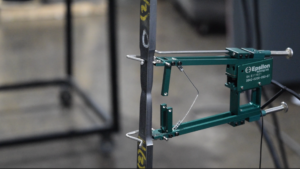What Is an Extensometer: A Primer for Engineers

Material testing can be tricky business. After all, you’re trying to measure something that may not be so easily measurable. That’s where extensometers come in! They are designed to help engineers measure deformation, strain and displacement when testing materials.
How Do Extensometers Work?
Extensometers work by applying a force to the material being tested and then measuring the amount of displacement that occurs as a result. This displacement can then be analyzed to determine properties such as tensile strength and elongation at break point. In addition, some types of extensometers also use other techniques such as laser interferometry or optical encoders to measure displacement with greater accuracy than traditional mechanical methods. The process of testing materials with an extensometer is relatively simple: first, the material being tested is placed between the two fixed points on the base of the extensometer. Then, a force is applied to one end of the material which causes it to expand or contract depending on its composition (e.g., metal expands when heated). As this happens, the two points on the sensor move relative to each other and this movement is measured by the extensometer’s internal sensors and displayed as a number on its display screen. The data collected from these tests can then be used to calculate various material properties including modulus of elasticity, yield strength, and tensile strength.
Why Is It Useful?
Extensometers are incredibly useful for engineers because they allow them to measure changes in materials’ length under different conditions such as temperature or pressure changes quickly and accurately without having to create complex calculations or use expensive equipment like calipers or micrometers. Additionally, because they measure strain rather than absolute displacement like traditional measuring instruments do, they provide engineers with more detailed information about how different materials respond under various conditions which can help them design better products in less time with fewer resources.
An extensometer is an invaluable tool for any engineer who needs accurate measurements quickly and easily without having to invest in complex equipment or perform complicated calculations manually. From measuring modulus of elasticity and yield strength to determining tensile strength of various materials under different conditions, an extensometer offers engineers precise results at lightning speed so they can get back to designing better products faster than ever before!
But with all the different types out there, how do you know which one is best for your project? Let’s take a look at the different types of extensometers available and explore their differences.
Strain Gage Extensometer
This type of extensometer measures strain using strain gages, which are devices that detect changes in length due to a force applied to the material being tested. Strain gage extensometers are often used in applications where accuracy is essential, such as measuring small displacements or deformations. They also have a wide range of applications, including medical device testing and aerospace engineering.
Linear Variable Displacement Transducer (LVDT)
The LVDT is an electrical transducer that measures displacement by converting linear motion into an electrical signal. It consists of three coils arranged around a core. Two outer coils create an alternating magnetic field while the center coil measures changes in this field due to displacement of the core from its initial position. This type of extensometer is ideal for measuring large displacements and has applications in automotive engineering and industrial automation.

Optical Extensometer
As its name suggests, optical extensometers use light-based techniques to measure deformation or strain in materials being tested. This technique works by sending two beams of light across an object from two different angles and then measuring any changes in the intensity or wavelength of these beams as they pass through the object due to deformation caused by stress or strain. Optical extensometers have gained popularity due to their high accuracy and versatility. They can be used for both static and dynamic measurements on a variety of materials such as metals, plastics, composites and ceramics.
Whether you need to measure displacement or strain, there’s an extensometer for it! Depending on your application, each type offers its own advantages – from increased accuracy with strain gages to versatility with optical sensors – so make sure you pick the right one for your project! With so many options available out there, Frank Bacon is here to help you pick out the right one for your testing needs
Contact Frank Bacon Today!
If you have any questions or are looking for a tensile tester please contact a sales engineer at Frank Bacon. We will walk you through the whole process and give you a customized turnkey machine.
Phone: 586-756-4280
Toll Free: 1-800-394-4280
Click here to view our Tensile Tester Inventory
Click here for NEW Tensile Tester Line
Click here to view our YouTube Channel
Check out this optical extensometer video at Frank Bacon.



